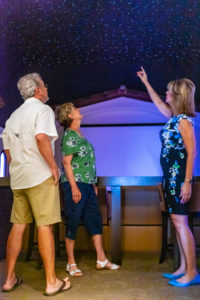He says clients with larger homes might consider budgeting $20,000 to $30,000 for smart home features, although some homeowners spend well over $100,000.
Now, business is booming, he says from his home, which offers panoramic views across Flagstaff toward Mormon Mountain through window glass selected to reflect heat back into the house – the opposite of glass used in warmer climates where reflectivity is pushed to the outside. Andy uses his home to demonstrate the many smart home technology options available to potential clients. And with household energy use nationwide accounting for around 20% of greenhouse gas emissions (according to the U.S. National Academy of Sciences) using smart devices can reduce your home energy bill, CO2 emissions and household water use.
Clients that Wired-Up Systems serves in the Quad Cities and Sedona have included the Central Yavapai Fire District Training Center, but most are residential customers. White sometimes inherits customers, but he prefers to install systems from the get-go.
He says clients with larger homes might consider budgeting $20,000 to $30,000 for smart home features, although some homeowners spend well over $100,000. On these projects, White builds integrated systems to meet specific client requirements, including writing custom apps and doing all the programming and implementation. Typically, features will include coordinated lighting, optimized heating and cooling (including window shading), water leak detection and shut off, not to mention fire alarms, security and audio-visual entertainment systems.
However, he says you don’t have to be a luxury homeowner or corporate client to take advantage of smart technology – there’s an increasing range of options for all budgets. For more modest homes, the do-it-yourself market now includes items such as smart lightbulbs and heating/cooling thermostats, which can all be controlled from an app on a smartphone.
If you’re going to adopt just one smart device, Andy White recommends a thermostat; quick and easy to install, it will save the homeowner money and reduce CO2 emissions. Example brands are Nest and Ecobee; some of these devices can even learn from the homeowner’s behavior over time, adapting home heating/cooling to match patterns of use, even optimizing it to times when renewable energy is most plentiful and cheapest. LED lightbulbs are a popular choice. They use at least 75% less energy than incandescent bulbs and last around 25 times longer. Adding a dimmer function can save up to another 40% of a household lighting bill.
Just about every home improvement and hardware store contacted in the Quad Cities confirmed that they do stock and sell some smart home devices (thermostats, lightbulbs and outlets you can control with an app on your phone are the most popular). But, despite the energy savings these devices can offer, several sales staff members said that with more than 50% of their customers aged 65 or older, that kind of technology is often a bit too complicated and overwhelming.
Realtor Barbara Bersch of Caldwell Bankers has sold a number of luxury homes in the Prescott area – making sure to highlight any smart home features of her listed properties. A large home in Mystic Heights, now sold, boasted in-home and mobile device control for lighting, temperature, humidity and air quality for 30 individual climate zones. It also included geothermal and solar heating, along with windows that dimmed with the intensity of the sun. But Bersch says that smart technology is, so far, only of interest to a small percentage of home buyers. Her sense is that for the Prescott market, where a large number of retirees are downsizing, long-term environmental impacts are not their main focus, with looks and location remaining the major selling points. Thus, she believes it could be a while before the younger, tech-savvy generation cycle into the housing market bringing with them a willingness to embrace smart home devices and the advanced energy saving features that technology offers. QCBN
By Diane Hope, QCBN







Leave a Reply